Vibration controllers are very sensitive to electrical noise and that noise is often visible in testing signals plots. It comes from two different sources of noise in vibration testing systems, ground loop noise, and Electromagnetic Interference (EMI). Both of these can cause a variety of problems.
EMI
EMI is also referred to as Radio Frequency Interference (RFI) and RF noise. It can be caused by a communication system, such as a CB radio, but more often by operating electronic devices, virtually anything from an electric drill to a garage door opener to fluorescent light ballasts; EMI can even be caused by electric power lines.
EMI can have a significant effect on a vibration testing system when the surrounding environment is electrically noisy. Long cables, poorly shielded cables, and components and certain amplifiers can, at times, act as antennae, pick up the EMI, and introduce it into the system.
Ground Loop Noise
In electrical and electronic systems, ‘ground’ has 2 different meanings, depending on the context.
-
- In power electricity, ground is a real, physical connection to the earth. It is commonly called an earth ground.
- In electronics, ground is not necessarily a connection to the real earth, but rather is a reference point to 0 Volts.
A ground loop happens when multiple devices, each with its own ground to the electrical power system, are connected to each other through some type of signal or communications cable that also carries a reference ground connection. This situation provides multiple paths to ground, through multiple devices, that can form a loop or loops. The loops pick up interference currents, creating electrical noise.
When the ground is an electronics 0-volt reference, it serves as the base for measuring any other voltages that might be generated throughout the system. When this 0 Volt reference is affected by ground loops, it is no longer exactly 0 Volts; some additional level of voltage is now present as the reference and can cause errors in the measurements used by the system.
Vibration control systems have a complete ground connection through a set of interconnecting cables going from: (1) the controller output to the amplifier, (2) the amplifier to the shaker, (3) the shaker to the control sensor and (4) the control sensor to the controller input. In addition to this complete loop of single-point ground references, the controller, amplifier, and shaker have safety ground references to earth ground. These multiple references to earth ground and the interconnected cabling all have an extremely high potential for creating ground loops.
Learn More
Our System Noise and Ground Loops VRU course gives more details on noise and ground loops, plus detailed steps for troubleshooting noise problems in your vibration testing system.


